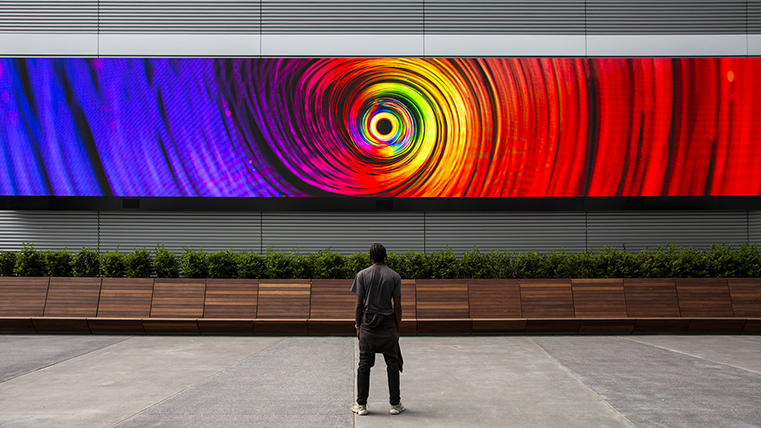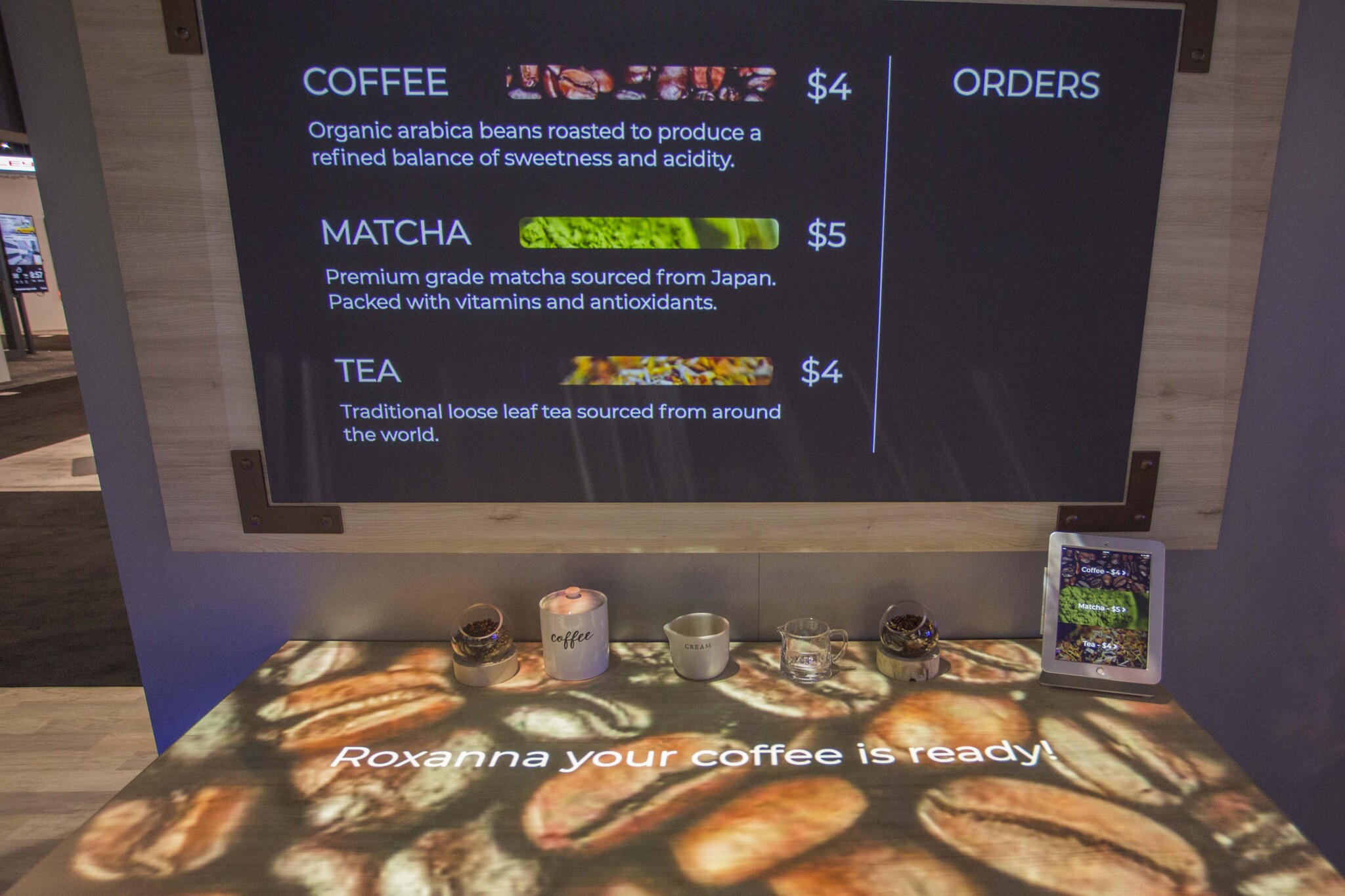Unexpected Connections: The Emotion Behind Good Content
Enhance the Power of Messaging With New Content Approaches

With the right approach and content, the subtle applications of digital signage can go a long way to telling a brand’s story. We often get bogged down in the technical aspects of content creation … and forget about the powerful emotions that can be invoked by content. So, let’s rethink the approach to content to forge emotional connections and craft meaningful, lasting stories.
Build Brand in Unexpected Ways
Stories lead consumers into a deeper knowledge of your brand, which results in more brand loyalty. Instead of an in-your-face advertisement or logo overload, the innovative use of content educates would-be buyers about your brand’s history and interesting personal backstories, leading to a strong emotional connection—your brand becomes like an old friend.
Too often, we overthink the technical aspects of digital signage and underthink the emotional connection. True brand connection arises not from the technical aspects of the signage, but from the message it conveys. In other words, content is king.
The right content shows highly targeted, personalized stories that engage audiences and contribute to imaginative place making. It’s adaptable and immersive.
Second Story’s chief creative officer Joel Krieger, challenges us to completely re-think how we look at spaces. “How do you brand a place? How can a media wall be used to set the emotional tone of an environment? How do we complement rather than compete with the existing architecture? These are all major challenges we face in the course of this kind of work, and things digital signage professionals should be thinking about.”
[The Integration Guide to Video Walls]
Signage as Brand Ambassador
Instead of making signage about the hard sell, think of it as more of a narrative device. Think of your workspace and its architecture as a canvas. Signage can transform it into a living, breathing depiction of a brand’s journey. It can even be used to show values, offer personalized welcomes to guests and clients, and to motivate team members.
A daily selection of the top stories for AV integrators, resellers and consultants. Sign up below.
Remi De Mar, senior product manager for visual displays, projectors, and augmented reality at Epson America, says that today’s digital signage solutions continue to collide with creative minds to deliver convenient, curated, and predictive solutions across a range of verticals to tell targeted brand stories
“Data mining combined with geo tracking, voice, and motion-sensing tools will eventually become ways in which many brand stories will become a curated white-glove experience,” Del Mar explained. “We are beginning to see many of these solutions in our space. For example, Intel’s RealSense cameras are being used in a variety of different use cases, from 3D scanning of a space to facial authentication, then combined with Epson projectors to create interactive and engaging spaces.”
[Download the 2020 Digital Signage Best Practices Guide]
Cybelle Jones, CEO of the Society for Experiential Graphic Designs (SEGD), points out that humans are oversaturated with technology, and believes we must become more focused on balancing the overarching experience for the end user by incorporating a more artistic approach.
“Consumers are responding to brands that understand their culture. The focus is shifting to how the brand provides a meaningful experience,” Jones said. “Curation of sound and sight is getting away from the brand in-your-face business model. The logo itself is not front and center, it’s moving beyond the brand to see what the story behind it is.”
Jones noted that there is a gap that currently exists in telling brand stories. We were raised in a culture where brand is king, she opined. Now, impact grows from the authenticity of the brand and a consumer’s experience of the brand.
The new approach should use digital signage to enhance common experiences for connection. Technologists should remember this phrase when creating content: “I like that brand because it respects the values I think about.”
Place-Making Should Leverage Signage Capabilities
Digital signage contributes to transformative experiences—an environment becomes dynamic based upon conditions you determine. It’s important to understand your audience demands, and to think about the purposeful and intentional design of a space. In an era of influencers and the entrance of Gen Z, the first digital native generation-digital, space transformations should have strong visual elements that are part of the connected and curated experience to help brands stand out.
“Provide a pulse of what can enhance a place-making experience,” Jones said. “For example, in certain instances you may want to embrace the regionality and locality of the brand. It makes the overall experience more transformative and personal. Capture our attention in a positive way to reinforce all things good.”
“For Epson and our digital experiences initiative, we have taken a consultative approach and work closely with our customers to guide them through the space-changing journey,” Del Mar said. “As a technology provider, we ask the qualitative questions to get to the heart of the applications and experiences they are trying to deliver. After gauging more insight, we are able to suggest the best display solutions that meet their goals and deliver their application needs.”
When it comes to choosing display technology, there are also pragmatic questions that need to be asked. This is where the integrator is essential in helping to determine appropriate technology for the space, based on the desired final experience. With projection mapping, for example, the physical space can morph as things disappear and re-appear.
Place-making with digital signage means that even with repeated visits to a retail outlet, corporate lobby, museum, restaurant, or airport, the experience can be completely unique because the signage messaging, mood, and narrative is continually shifting.

“You can use media architecture to help root a new place in the public imagination,” Krieger explained. “Unlike the advertising that blares from typical large screens, the mesmerizing cadence and ambient nature of this approach complements the built environment rather than competes with it. The result is an emotive expression of place that enhances the daily experience of the community.”
Targeted Stories with Automation
With digital signage, AV professionals have the opportunity to shift their messages in real time, adapting to the audience that encounters the signage. Digital content can evolve according to the personalized information it receives from sensors and data sets, and this means users can tell a more meaningful, resonant story.
This approach has practical, as well as emotional, benefits. In this more safety-centric culture, signage manufacturers are moving away from touch, so tapping into other personalized data makes sense
“Voice recognition and gesture control will likely replace touch—but our need for visual cues and displays will only grow,” Epson’s Del Mar pointed out. “Additionally, I believe that AR will play a huge role in bridging the gap between physical and digital experiences as we look toward the future.”
An Emotional Response to Signage
When it’s all said and done, the point of re-thinking how we approach digital signage content is to place a greater emphasis on long-term brand loyalty—rather than impulse decision-making—by building strong emotional connections. In doing so, the end result is increased engagement over time. This approach applies to everything from houses of worship to restaurants, and corporate offices to entertainment venues.
Leverage signage as a brand ambassador, its place-making abilities, the unique attributes of automation, and the move toward audience interaction to drive your digital signage discussions.
For those arriving, passengers are guided to the correct baggage carousel by unique, freestanding displays composed of 49-inch webOS signage mounted on top of 86-inch 4K UHD signage displays. Designed for maximum visibility, the UHD screens display colorful airport information and advertising videos at ultra-high resolution, while the webOS signage informs passengers where to pick up their luggage.
LG’s 88-inch Ultra Stretch displays, playing Russian cultural vignettes, adorn the columns in Terminal B’s baggage claim area. Able to fit on the columns thanks to their 32:9 display ratio, these sleek Ultra Stretch displays give the terminal a modern visual enhancement.
LG FIDS are strategically placed throughout Terminal B. Both LED and webOS FIDS are designed for durability and 24/7 operation to make sure that passengers don’t miss their flights. Especially striking is the 42-square meter FIDS that greets passengers in the departures hall. Made of multiple bezel-less LED units grouped together, this FIDS’ massive scale allows Sheremetyevo to display a large amount of flight information at once, minimizing the amount of time passengers must wait to see their flight’s status.
“This project is the biggest and most impressive installation of digital signage in the Russian transportation industry. Reliable product quality was very critical. For this, LG was the best partner we could have had, thanks to its global reputation as a leader in the digital signage industry,” said Ludmila Ignatova, general manager, Tegrus (LG system integrator partner).
Capturing Imaginations
Despite the short timeframe for installation and troubleshooting, each and every piece of digital signage within Terminal B has been operating beautifully from the get-go. The FIDS also operate reliably, providing passengers with essential flight information. Sheremetyevo officials are more than pleased with the results.
“The equipment we received perfectly meets our needs, and we are very pleased to have worked with LG. Every day, we can see the ‘wow’ factor the digital signage displays provide our passengers,” said Kirill Kulikov, head of IT infrastructure, Sheremetyevo International Airport.
A Lasting Impression
Terminal B’s usage of digital signage as works of art immediately captured the attention of passengers. The enormous LED signage totem and two Circle and Cube installations became talking points, and have even trended on social media at times.
Visitors may only pass through the airport for small window of time, but there is no doubt the video walls and their cutting-edge content leave an impression long after the visitors have returned home. Russian culture and art will remain as a positive memory for those who have the opportunity to soak it all in.
Camille Burch is a creative thinker, marketing strategist, and award-winning writer. She is the current editor of Digital Signage Magazine.

